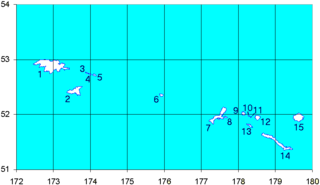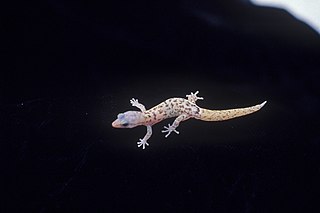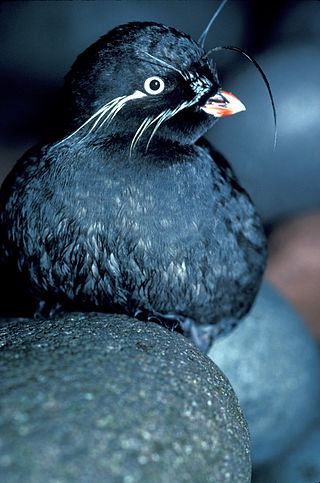
The Puerto Rican dry forests are a tropical dry forest ecoregion located in southwestern and eastern Puerto Rico and on the offshore islands. They cover an area of 1,300 km2 (500 sq mi). These forests grow in areas receiving less than 1,000 mm (39 in) of rain annually. Many of the trees are deciduous, losing their leaves during the dry season which normally lasts from December to April.

The ecological restoration of islands, or island restoration, is the application of the principles of ecological restoration to islands and island groups. Islands, due to their isolation, are home to many of the world's endemic species, as well as important breeding grounds for seabirds and some marine mammals. Their ecosystems are also very vulnerable to human disturbance and particularly to introduced species, due to their small size. Island groups such as New Zealand and Hawaii have undergone substantial extinctions and losses of habitat. Since the 1950s several organisations and government agencies around the world have worked to restore islands to their original states; New Zealand has used them to hold natural populations of species that would otherwise be unable to survive in the wild. The principal components of island restoration are the removal of introduced species and the reintroduction of native species.

Hawadax Island is an island in the Rat Islands archipelago of the western Aleutian Islands in the U.S. state of Alaska. The island was formerly known as Rat Island until May 2012 when it was renamed Hawadax Island, which is an Aleut name meaning "entry" and "welcome". The island has a land area of 10.3126 sq mi (26.7095 km²) and no permanent population. It is within the Alaska Maritime National Wildlife Refuge. It is 9.3 miles (15 km) in length and 3.1 miles (5 km) in width.

Lehua Island is a small, crescent-shaped island in the Hawaiian islands, 0.7 miles (1.1 km) north of Niʻihau, due west of Kauai. The uninhabited, 285-acre (1.15 km2) barren island is a tuff cone which is part of the active Niʻihau volcano.

Desecheo is a small uninhabited island of the archipelago of Puerto Rico located in the northeast of the Mona Passage; 13 mi (21 km) from Rincón on the west coast of the main island of Puerto Rico and 31 mi (50 km) northeast of Mona Island. It has a land area of 0.589 sq mi. Politically, the island is administered by the U.S. Department of the Interior, U.S. Fish and Wildlife Service as the Desecheo National Wildlife Refuge, but part of Barrio Sabanetas of Mayaguez.

Kīlauea Point National Wildlife Refuge is a National Wildlife Refuge on the northwest coast of the island of Kauaʻi in Hawaiʻi.

The Monito gecko is a lizard, a species of gecko endemic to the island of Monito, in the archipelago of Puerto Rico.

The Spanish Virgin Islands, formerly called the Passage Islands and also known as the Puerto Rican Virgin Islands, West Virgin Islands primarily consisting of the islands of Culebra and Vieques, are part of the Commonwealth of Puerto Rico and are located east of the main island of Puerto Rico in the Caribbean.

The fauna of Puerto Rico is similar to other island archipelago faunas, with high endemism, and low, skewed taxonomic diversity. Bats are the only extant native terrestrial mammals in Puerto Rico. All other terrestrial mammals in the area were introduced by humans, and include species such as cats, goats, sheep, the small Indian mongoose, and escaped monkeys. Marine mammals include dolphins, manatees, and whales. Of the 349 bird species, about 120 breed in the archipelago, and 47.5% are accidental or rare.
Caribbean Islands National Wildlife Complex is an administrative unit of the United States Fish and Wildlife Service which oversees National Wildlife Refuges in Puerto Rico, the U.S. Virgin Islands, and Navassa Island of the U.S. Minor Outlying Islands. The NWR complex also manages the reintroduction of the critically endangered Puerto Rican parrot into the wild.

Aethia is a genus of four small (85–300g) auklets endemic to the North Pacific Ocean, Bering Sea and Sea of Okhotsk and among some of North America's most abundant seabirds. The relationships between the four true auklets remains unclear. Auklets are threatened by invasive species such as Arctic foxes and Norway rats because of their high degree of coloniality and crevice-nesting.
Myrcia neothomasiana, commonly known as Thomas' lidflower, is a rare species of plant in the family Myrtaceae. It is found on three Caribbean islands. There are fewer than 250 individuals total divided amongst the islands of Vieques in Puerto Rico, St. John in the United States Virgin Islands, and Virgin Gorda in the British Virgin Islands. It has been extirpated from the wild on Saint Thomas, U.S. Virgin Islands, where it was first described in 1855, and now only grows there in cultivation.

Harrisia portoricensis is a species of cactus in the genus Harrisia. Its common names include higo chumbo and Puerto Rico applecactus.
Franklin Island National Wildlife Refuge is a National Wildlife Refuge on Franklin Island outside Muscongus Bay in the state of Maine, United States. It is one of the five refuges that together make up the Maine Coastal Islands National Wildlife Refuge, along with Petit Manan, Cross Island, Seal Island, and Pond Island.

Seabirds include some of the most threatened taxa anywhere in the world. For example, of extant albatross species, 82% are listed as threatened, endangered, or critically endangered by the International Union for Conservation of Nature. The two leading threats to seabirds are accidental bycatch by commercial fishing operations and introduced mammals on their breeding islands. Mammals are typically brought to remote islands by humans either accidentally as stowaways on ships, or deliberately for hunting, ranching, or biological control of previously introduced species. Introduced mammals have a multitude of negative effects on seabirds including direct and indirect effects. Direct effects include predation and disruption of breeding activities, and indirect effects include habitat transformation due to overgrazing and major shifts in nutrient cycling due to a halting of nutrient subsidies from seabird excrement. There are other invasive species on islands that wreak havoc on native bird populations, but mammals are by far the most commonly introduced species to islands and the most detrimental to breeding seabirds. Despite efforts to remove introduced mammals from these remote islands, invasive mammals are still present on roughly 80% of islands worldwide.
Morgan Island is one of the Sea Islands, located in Beaufort County, South Carolina, just north of Beaufort. It is also known as Monkey Island due to its colony of free-ranging rhesus monkeys, established in 1979.
Kenneth E. Stager was an American ornithologist who served as a curator at the Natural History Museum of Los Angeles County.

Island Conservation is a non-profit organization with the mission to prevent extinctions by removing invasive species from islands. Island Conservation has therefore focused its efforts on islands with species categorized as Critically Endangered and Endangered on the IUCN's Red List. Working in partnership with local communities, government management agencies, and conservation organizations, Island Conservation develops plans and implements the removal of invasive alien species, and conducts field research to document the benefits of the work and to inform future projects.

Mona and Monito Islands Nature Reserve consists of two islands, Mona and Monito, in the Mona Passage off western Puerto Rico in the Caribbean. Mona and Monito Islands Nature Reserve encompasses both land and marine area, and with an area of 38,893 acres it is the largest protected natural area in the Commonwealth of Puerto Rico. Much like the Galapagos Islands in the Pacific Ocean, the Mona and Monito Islands reserve represents a living laboratory for archaeological, biological, geological, oceanographical and wildlife management research.















